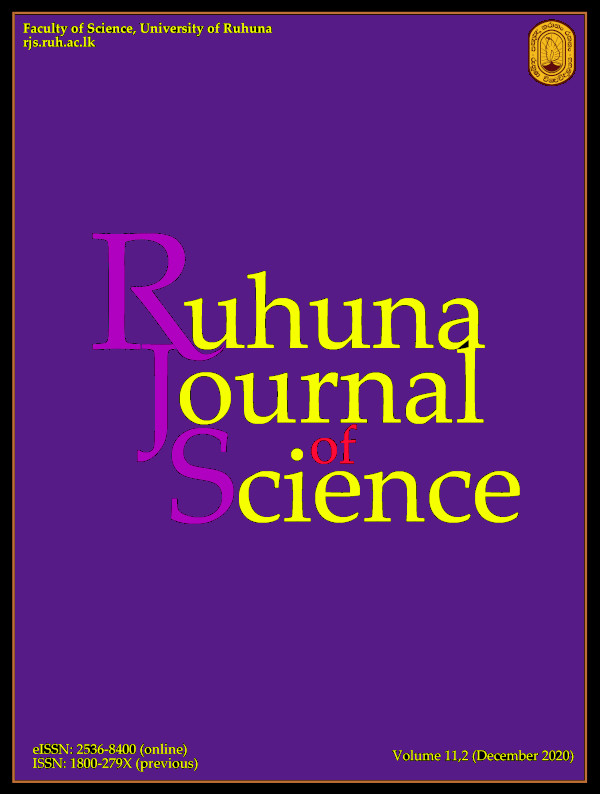Antioxidant and anti-inflammatory potential, and chemical composition of fractions of ethanol extract of Annona muricata leaf
Abstract
Serious health challenges have been associated with inflammation which is a major cause of mortality in the world. This study evaluated the antioxidant, anti-inflammatory potential, and chemical compositions of fractions of ethanol extract of Annona muricata leaf. The leaves were dried at room temperature, blended and extracted in sequential with solvents of varying degree of polarities, i.e., n-hexane, ethyl acetate and ethanol. Ethanol extract was fractionated via solvent-solvent partitioning into five fractions, i.e., n-hexane fraction (F1), dichloromethane fraction (F2), dichloromethane/ methanol (1:1) fraction (F3), methanol fraction (F4), and ethanol fraction (F5). These fractions were examined for their in-vitro antioxidant activities on DPPH, ABTS and H2O2 while the anti-inflammatory activities were investigated using lipoxygenase inhibition, proteinase inhibition and membrane stabilization assays. The F4 being the most active fraction was further analyzed with GCMS to determine its chemical compositions. The results showed that F4 had the highest H2O2 scavenging activity at 10–100 µg/mL. The activity of F4 at 50 µg/mL was significantly higher (P<0.05) than that of other treatments including the standard (Vitamin C). Activity of F4 also showed significantly higher (P<0.05) membrane stabilization than other fractions at 50-100 µg/mL. F4 exhibited higher antioxidant and anti-inflammatory activities than the other fractions. The activity of this fraction could be attributed to the synergetic effect of various antioxidant compounds present in the fraction. Some of the bioactive compounds identified in the GC-MS of F4 were coumaran, tyrosol, phytol, tetracosanol, elaidic acid methyl ester and β-sitosterol. Keywords: Bioactivity, concentration, inhibition, radical scavengingReferences
Agu KC, Okolie PN. 2017. Proximate composition, phytochemical analysis and in-vitro antioxidant potentials of extracts of Annona muricata (Soursop). Food Science and Nutrition 5:1029-1036.
Amri O, Zekhnini A, Bouhaimi A, Tahrouch S, Hatimi A. 2018. Anti-inflammatory activity of methanolic extract from the Pistacia atlantica Desf. Leaves. Pharmacognosy Journal 10(1): 71-76.
Baskar R, Rajeswari V, Kumar TS. 2007. In-vitro antioxidant studies in leaves of Annona species. Indian Journal of Experimental Biology 45(5): 480 – 485.
Cora-Tellez AV, Montalvo-Gonzalez E, Yahia EM, Obledo-Vazquez EN. 2018. Annona muricata: A review on its traditional medicinal uses, phytochemicals, pharmacological activities, mechanism of action and toxicity. Arabian Journal of Chemistry 11(5): 662-691.
Jothi BA, Geetha B. 2017. GCMS and FTIR analysis of bioactive compounds on methanol extract of Ipomoea aquatic. International Journal of Fisheries and Aquatic Research 2(3): 12 – 16.
Krishnamoorthy K, Senguttuvan J, Gurunathan A, Arjunan V, Krishnaswamy T, Subramanian P. 2016. Evaluation of anti-inflammatory and antioxidant properties of crude extract and forskolin from Solena amplexicaulis leaf. Indian Journal of Pharmaceutical Sciences 78(3): 377-387.
Leelaprakash G, Das SM. 2011. In-vitro anti-inflammatory activity of methanol extract of Enicostemma axillare. International Journal of Drug Development and Research 3(3): 189 – 196.
Leon-Fernandez AE, Sayago-Ayerdi SG, Velazquez-Estrada RM, Zepeda-Vallejo LG, Yahia E, Montalvo-Gonzalez E. 2017. In-vitro antioxidant capacity of crude extracts and acetogenin fraction of soursop fruit pulp. Pharmaceutica Analytica Acta 8(6): 550 – 556. DOI: 10.4172/2153-2435.1000550.
Moghadamtousi SZ, Fadaeinasab M, Nikzad S, Mohan G, Ali HM, Kadir HA. 2015. Annona muricata (Annonaceae): A review of its traditional uses, isolated acetogenins and biological activities. International Journal of Molecular Sciences 16: 15625-15658.
Nishaa S, Vishnupriya M, Sasikumar JM, Hephzibah PC, Gopalakrishnan VK. 2012. Antioxidant activity of ethanolic extract of Maranta arundinacea L. tuberous rhizomes. Asian Journal of Pharmaceutical and Clinical Research 5(4): 85 – 88.
Nwaehujor I, Olatunji G, Atolani O, Akande S. 2020. Studies on in-vitro anti-inflammatory and antioxidant potentials of the leaf extracts of Annona muricata. Croatian Journal of Food Science and Technology 12(2). DOI: 10.17508/CJFST.2020.12.2.xx IN PRESS.
Orak HH, Bahrisefit IS, Sabudak T. 2019. Antioxidant activity of the extracts of soursop (Annona muricata L.) leaves, fruits pulps, peels and seeds. Polish Journal of Food and Nutrition Sciences 69(4): 359 – 366. DOI: 10.31883/pjfns/112654.
Perumal SS, Ekambaram SP, Dhanam T. 2017. In-vivo antiarthritic activity of the ethanol extracts of stem bark and seeds of Calophyllum inophyllum in Freund’s complete adjuvant induced arthritis. Pharmaceutical Biology 55(1): 1330 – 1336.
Steele VE, Holmes CA, Hawk ET, Kopelovich L, Lubet RA, Crowell JA, Sigman CC, Kelloff GJ. 1999. Review: Lipoxygenase inhibitors as potential cancer chemopreventives. Cancer Epidemiology, Biomarkers and Prevention 8: 467 – 483.
Sumathi S, Anuradha R. 2016. In-vitro anti-inflammatory activity of flower extract of Couroupita guianensis Aubl. International Journal of Herbal Medicine 4(5): 05 – 08.
Usunobun U, Okolie NP, Anyanwu OG, Adegbegi AJ, Egharevba ME. 2015. Phytochemical screening and proximate composition of Annona muricata leaves. European Journal of Botany Plant Science and Phytology 2(1): 18-28.
Downloads
Published
Issue
Section
License
From Volume 7 (2016) onwards, all articles published in Ruhuna Journal of Science are Open Access articles published under the Creative Commons CC BY-NC 4.0 International License. This License permits use, distribution and reproduction in any medium, provided the original work is properly cited and is not used for commercial purposes.
Copyright on any research article published in RJS is retained by the respective author(s).
Authors who publish with this journal agree to the following terms:
a) Authors retain copyright and grant the journal right of first publication with the work simultaneously licensed under a Creative Commons Attribution License CC-BY-NC 4.0 International, that allows others to share the work with an acknowledgement of the work's authorship and initial publication in this journal.
b) Authors are able to enter into separate, additional contractual arrangements for the non-exclusive distribution of the journal's published version of the work (e.g., post it to an institutional repository or publish it in a book), with an acknowledgement of its initial publication in this journal.
c) Authors are permitted and encouraged to post their work online (e.g., in institutional repositories or on their website) prior to and during the submission process, as it can lead to productive exchanges, as well as earlier and greater citation of published work (See The Effect of Open Access).

